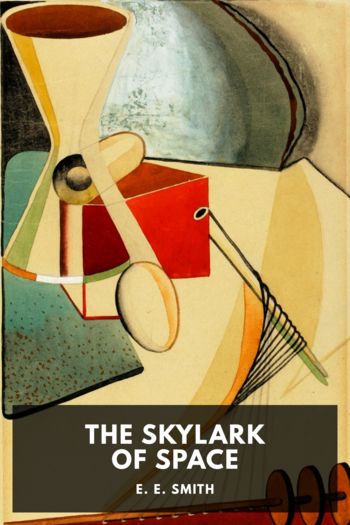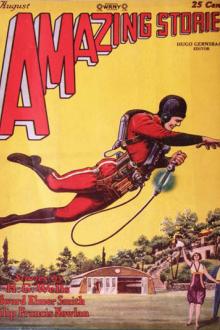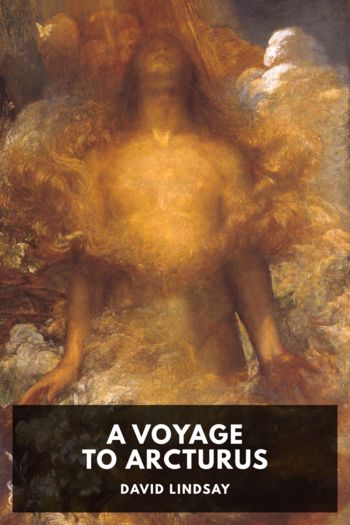The Skylark of Space, E. E. Smith [books to read in your 20s .txt] 📗

- Author: E. E. Smith
Book online «The Skylark of Space, E. E. Smith [books to read in your 20s .txt] 📗». Author E. E. Smith
Returning to the others, they found Dorothy and Sitar deep in conversation.
“So a man has half a dozen or so wives?” Dorothy was asking in surprise. “How do you get along together? I’d fight like a wildcat if my husband tried to have other wives!”
“We get along splendidly, of course,” returned the Osnomian princess in equal surprise. “I would not think of being a man’s only wife. I wouldn’t consider marrying a man who could win only one wife—think what a disgrace it would be! And think how lonely one would be while her husband is away at war—we would go insane if we did not have the company of the other wives. There are six of us, and we could not get along at all without each other.”
“I’ve got a compliment for you and Peggy, Dottie,” said Seaton. “Dunark here thinks that you two girls look good enough to eat—or words to that effect.” Both girls flushed slightly, the purplish-black color suffusing their faces. They glanced at each other and Dorothy voiced the thought of both as she said:
“How can you, Kofedix Dunark? In this horrible light we both look perfectly dreadful. These other girls would be beautiful, if we were used to the colors, but we two look simply hideous.”
“Oh, no,” interrupted Sitar. “You have a wonderfully rich coloring. It is a shame to hide so much of yourselves with robes.”
“Their eyes interpret colors differently than ours do,” explained Seaton. “What to us are harsh and discordant colors are light and pleasing to their eyes. What looks like a kind of sloppy greenish black to us may—in fact, does—look a pale pink to them.”
“Are Kondal and Mardonale the only two nations upon Osnome?” asked Crane.
“The only civilized nations, yes. Osnome is divided into two great and almost equal continents, separated by a wide ocean which encircles the globe. One is Kondal, the other Mardonale. Each nation has several nations or tribes of savages, which inhabit various waste places.”
“You are the light race, Mardonale the dark,” continued Crane. “What are the servants, who seem halfway between?”
“They are slaves …”
“Captured savages?” interrupted Dorothy.
“No. They are a separate race. They are a race so low in intelligence that they cannot exist except as slaves, but they can be trained to understand language and to do certain kinds of work. They are harmless and mild, making excellent servants, otherwise they would have perished ages ago. All menial work and most of the manual labor is done by the slave race. Formerly criminals were sterilized and reduced to unwilling slavery, but there have been no unwilling slaves in Kondal for hundreds of karkamo.”
“Why? Are there no criminals any more?”
“No. With the invention of the thought recorder an absolutely fair trial was assured and the guilty were all convicted. They could not reproduce themselves, and as a natural result crime died out.”
“That is,” he added hastily, “what we regard as crime. Duelling, for instance, is a crime upon Earth; here it is a regular custom. In Kondal duels are rather rare and are held only when honor is involved, but here in Mardonale they are an everyday affair, as you saw when you landed.”
“What makes the difference?” asked Dorothy curiously.
“As you know, with us every man is a soldier. In Kondal we train our youth in courage, valor, and high honor—in Mardonale they train them in savage bloodthirstiness alone. Each nation fixed its policy in bygone ages to produce the type of soldier it thought most efficient.”
“I notice that everyone here wears those heavy collars,” said Margaret. “What are they for?”
“They are identification marks. When a child is nearly grown, a collar bearing his name and the device of his house is cast about his neck. This collar is made of arenak, a synthetic metal which, once formed, cannot be altered by any usual means. It cannot be scratched, cut, bent, broken, or worked in any way except at such a high temperature that death would result, if such heat were applied to the collar. Once the arenak collar is cast about a person’s neck he is identified for life, and any adult Osnomian not wearing a collar is put to death.”
“That must be an interesting metal,” remarked Crane. “Is your belt a similar mark?”
“This belt is an idea of my own,” and Dunark smiled broadly. “It looks like opaque arenak, but isn’t. It is merely a pouch in which I carry anything I am particularly interested in. Even Nalboon thought it was arenak, so he didn’t trouble to try to open it. If he had opened it and taken my tools and instruments, I couldn’t have built the educator.”
“Is that transparent armor arenak?”
“Yes, the only difference being that nothing is added to the matrix to color or make opaque the finished metal. It is in the preparation of this metal that salt is indispensable. It acts only as a catalyst, being recovered afterward, but neither nation has ever had enough salt to make all the armor they want.”
“Aren’t those monsters—karlono, I think you called them—covered by the same thing? And what are those animals, anyway?” Dorothy asked.
“Yes, they are armored with arenak, and it is thought that the beasts grow it, the same as fishes grow scales. The karlono are the most frightful scourge of Osnome. Very little is known of them, though every scientist has theorized upon them since time immemorial. It is very seldom that one is ever killed, as they easily outfly our swiftest battleships, and only fight when they can be victorious. To kill one requires a succession of the heaviest high-explosive shells in the same spot, a joint in the armor; and after the armor is once penetrated, the animal is blown into such small fragments that reconstruction is impossible. From such remains it has been variously described as a bird, a beast, a fish, and a vegetable; sexual, asexual, and hermaphroditic. Its habitat is unknown, it being





Comments (0)